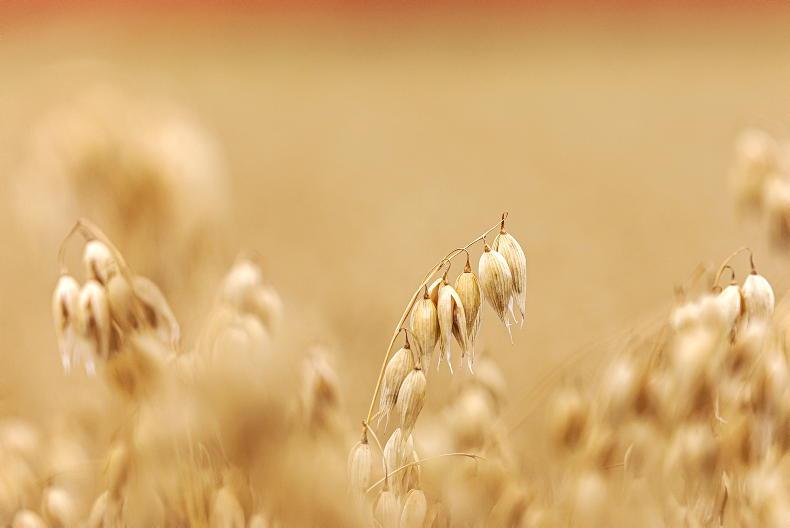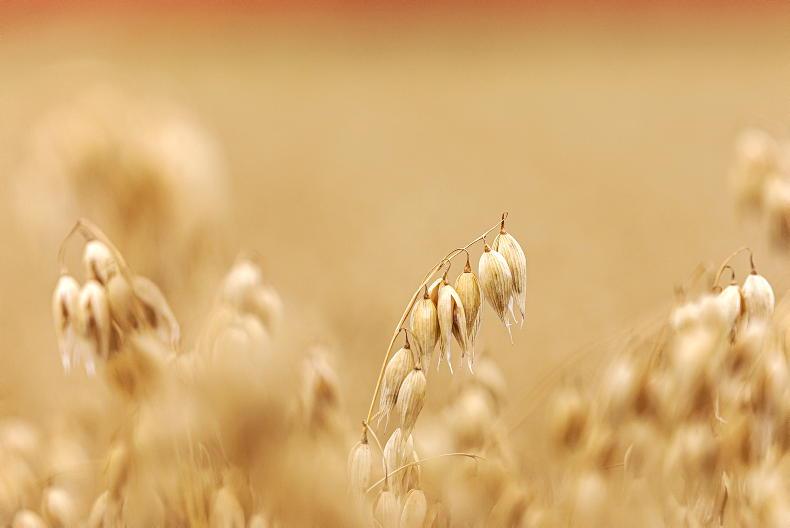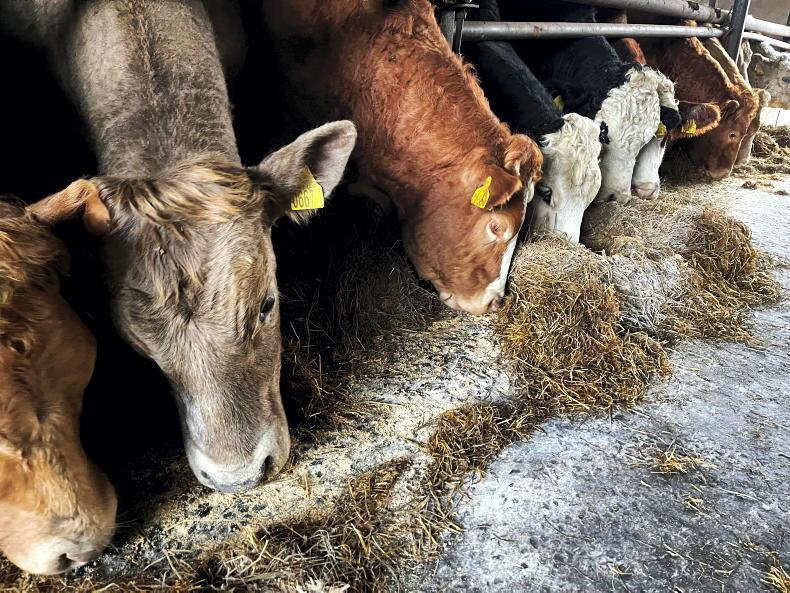With an increased interest in using native feed and homegrown rations in cattle diets in recent years, a trial carried out in Teagasc Grange has looked at the effect of replacing barley with oats in a finishing diet.
It also looked at feeding higher protein diets using either peas or beans on the performance and carcase characteristics of continental finishing bullocks.
Seventy-two suckler-bred, late-maturing bullocks were put on one of six finishing diets.
1. Rolled barley.2. Rolled barley and flaked peas.3. Rolled barley and flaked beans.4. Rolled oats.5. Rolled oats and flaked peas.6. Rolled oats and flaked beans.Each concentrate type also contained 5% molasses and was balanced for vitamins and minerals.
The rations with added protein constituents (peas or beans) were formulated to have a crude protein level of 14.4%, while the cereal-only diets had a crude protein of 11.6%.
All groups were fed 4kg/day of the ration on a dry matter basis. This was split between morning and evening feeds.
Alongside the concentrate types, all bullocks were offered ad-lib grass silage, which was 72.5% DMD and had a crude protein level of 15.2%, so, in other words, it was a good-quality silage being offered.
At the start of the trial, the bullocks were 21 months old and had an average weight of 596kg. The feeding trial lasted just shy of five months (146 days).
Little difference
Interestingly, there was very little difference in performance between diet types. The experiment also measured cattle intakes and there was no difference between groups.
Looking solely at barley versus oats, daily liveweight gains were the same at 0.64kg/day. Carcase weight was not significantly different at 402kg for barley and 405kg for oats and there was no difference in conformation or fat score between either diets.
However, the rations containing peas tended to have a slightly lower daily liveweight gain at 0.58kg/day. This was reflected in a lower carcase weight of those animals on the protein diets – 396kg for peas compared with 405kg for beans.
The study conclusions were that the feed value of oats was equal to barley in this case, while beans was superior to peas. The higher protein rations had no benefit over the cereal-only diets and in the case of peas, carcase growth was negatively impacted.
With ration prices €50 to €60/t greater this winter compared with last year, there may be some options to use oats in finishing diets.
However, it should be noted that the silage quality used in this trial was of very good quality. It would be interesting to see if the same results would hold true on a lower DMD silage.
The protein content of the silage used was also very high at 15.2% - probably 2% to 3% higher than what many farms would have in the yard this winter and I would be interested to see the same trial carried out on say a 12% protein silage as I feel the results may be different.
When feeding finishing animals, high levels of protein are not as important as they are with cattle that are growing frame.
The lower performance of the added protein rations could be due to the higher overall diet protein. Too much protein comes at a cost to the system, as the animal must burn some energy in order to process the protein through the digestive system.
A total diet crude protein level of between 11% and 12% would be sufficient for finishing animals.
With an increased interest in using native feed and homegrown rations in cattle diets in recent years, a trial carried out in Teagasc Grange has looked at the effect of replacing barley with oats in a finishing diet.
It also looked at feeding higher protein diets using either peas or beans on the performance and carcase characteristics of continental finishing bullocks.
Seventy-two suckler-bred, late-maturing bullocks were put on one of six finishing diets.
1. Rolled barley.2. Rolled barley and flaked peas.3. Rolled barley and flaked beans.4. Rolled oats.5. Rolled oats and flaked peas.6. Rolled oats and flaked beans.Each concentrate type also contained 5% molasses and was balanced for vitamins and minerals.
The rations with added protein constituents (peas or beans) were formulated to have a crude protein level of 14.4%, while the cereal-only diets had a crude protein of 11.6%.
All groups were fed 4kg/day of the ration on a dry matter basis. This was split between morning and evening feeds.
Alongside the concentrate types, all bullocks were offered ad-lib grass silage, which was 72.5% DMD and had a crude protein level of 15.2%, so, in other words, it was a good-quality silage being offered.
At the start of the trial, the bullocks were 21 months old and had an average weight of 596kg. The feeding trial lasted just shy of five months (146 days).
Little difference
Interestingly, there was very little difference in performance between diet types. The experiment also measured cattle intakes and there was no difference between groups.
Looking solely at barley versus oats, daily liveweight gains were the same at 0.64kg/day. Carcase weight was not significantly different at 402kg for barley and 405kg for oats and there was no difference in conformation or fat score between either diets.
However, the rations containing peas tended to have a slightly lower daily liveweight gain at 0.58kg/day. This was reflected in a lower carcase weight of those animals on the protein diets – 396kg for peas compared with 405kg for beans.
The study conclusions were that the feed value of oats was equal to barley in this case, while beans was superior to peas. The higher protein rations had no benefit over the cereal-only diets and in the case of peas, carcase growth was negatively impacted.
With ration prices €50 to €60/t greater this winter compared with last year, there may be some options to use oats in finishing diets.
However, it should be noted that the silage quality used in this trial was of very good quality. It would be interesting to see if the same results would hold true on a lower DMD silage.
The protein content of the silage used was also very high at 15.2% - probably 2% to 3% higher than what many farms would have in the yard this winter and I would be interested to see the same trial carried out on say a 12% protein silage as I feel the results may be different.
When feeding finishing animals, high levels of protein are not as important as they are with cattle that are growing frame.
The lower performance of the added protein rations could be due to the higher overall diet protein. Too much protein comes at a cost to the system, as the animal must burn some energy in order to process the protein through the digestive system.
A total diet crude protein level of between 11% and 12% would be sufficient for finishing animals.










SHARING OPTIONS